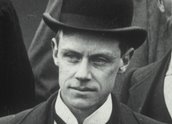
The Hen Convention (1897)
Synopsis
The Hen Convention, a novelty song with piano accompaniment and featuring imitations of a chook, is the earliest known Australian sound recording.
Curator’s notes
The Hen Convention was recorded before 15 January 1897 by an amateur sound recordist, Thomas Rome, and featured the voice of Warrnambool performer John James Villiers (you can see photographs of both men on the Extras page). The Hen Convention recording was part of a collection discovered by Melbourne film and audio historian Chris Long in the 1980s. It was Long’s research on the content, condition and provenance of the collection, as well as on the life of Thomas Rome, that established the significance of the material.
The recording reveals a gathering of members of several poultry species such as Malay, Bantam and Chittagong chickens. There is some speculation that this piece was popular at the time of the Constitutional conventions and possibly that each of the ‘chooks’ mentioned in the song could correspond to major personalities involved in the political debates of the period.
The comic turn may have started life as a minstrel show, or derived from a minstrel tradition, with phrases such as ‘Mister Rooster Shanghai de biggest swell of all’. In fact, 'A Hen Convention as performed by Mr Harry Leslie’, was listed on the program of ‘songs, ballades, choruses and Plantation Festival illustrating the Life, Manners and Minstrelsy of the Southern Negroes’ at Coppin’s Apollo Music Hall, Melbourne, as advertised in The Argus newspaper on 23 August 1862.
An early adopter of new technology, Thomas Rome imported up-to-the-minute equipment from the USA. He perhaps hoped that the expense of purchase would be covered by selling tickets to ‘the Most Wonderful Machine that the Ingenuity of Man has Ever Produced’ as extolled in his brochure. This technology, which held recordings in the grooves on the outside of hollow cylinders made of wax, was the earliest medium for recording and reproducing sound.
Called a phonograph, performers would speak or sing into a funnel-shaped horn attached to a guide-rail. A feed-screw drove the horn gradually along the guide-rail from the start of the cylinder to the other end. As the cylinder rotated, the end of the horn followed a spiral pattern over the surface of the cylinder. The sound vibrated a diaphragm attached to the sharp stylus which moved up and down rapidly to cut a groove in the surface of the wax cylinder.
Rome, who hailed from Warrnambool in Victoria, demonstrated the Edison Spring Motor Phonograph, one of the first portable Edison models, at the Warrnambool Industrial and Art Exhibition in 1896–97. At his stall, people were able to listen on ‘Ear receivers’ ('carefully washed in hot carbolic solution several times a day’) to a set of American commercial recordings, but also to some of Rome’s own recordings including ‘The Hen Convention’.
Rome also created other recordings, including the re-creation of a real incident from the local area. In March 1897, a train running between Allansford and Warrnambool was derailed. Rome recorded a dramatic portrayal of the incident and drew upon the skills of George Twentyman, known as 'Herr Schoot the Demon Drummer’ and holder of the title Champion Descriptive Drummer of the World, who created impressive train sound effects. You can hear this recording on the Extras page.
Following the exhibition, Rome demonstrated his phonograph on several other occasions. He married in 1901 and started a family and in 1907 opened his own business running a boot shop. After Chris Long discovered his collection, one of Rome’s sons, Dr Ronald Rome, sold the sound equipment, recordings and accessories to the Performing Arts Collection at the Arts Centre in Melbourne.
Long produced a sound documentary, The Fabulous Phonograph of Thomas J Rome (1984), and wrote about the collection for the International Association of Sound Archives Australian Branch Newsletter ('Australia’s Earliest Known Recordings: Thomas Rome’s Collection’, 1985, issue 19). In 2000 the Thomas Rome collection was transferred to the National Film and Sound Archive from the Arts Centre in Melbourne.
- Overview
- Curator’s notes
- Audio full title
- Principal credits
- Find a copy
- Comments 1
- Extras
- Add your review



